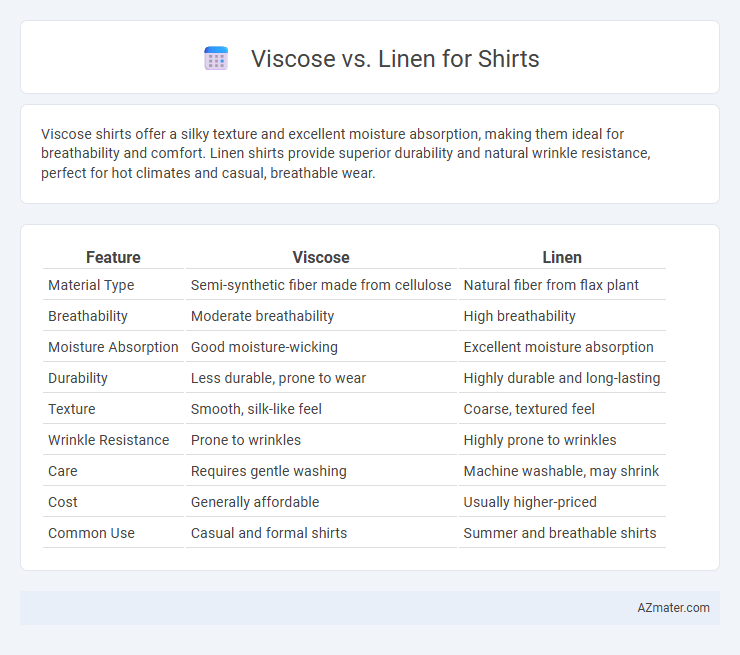Viscose shirts offer a silky texture and excellent moisture absorption, making them ideal for breathability and comfort. Linen shirts provide superior durability and natural wrinkle resistance, perfect for hot climates and casual, breathable wear.
Table of Comparison
| Feature | Viscose | Linen |
|---|---|---|
| Material Type | Semi-synthetic fiber made from cellulose | Natural fiber from flax plant |
| Breathability | Moderate breathability | High breathability |
| Moisture Absorption | Good moisture-wicking | Excellent moisture absorption |
| Durability | Less durable, prone to wear | Highly durable and long-lasting |
| Texture | Smooth, silk-like feel | Coarse, textured feel |
| Wrinkle Resistance | Prone to wrinkles | Highly prone to wrinkles |
| Care | Requires gentle washing | Machine washable, may shrink |
| Cost | Generally affordable | Usually higher-priced |
| Common Use | Casual and formal shirts | Summer and breathable shirts |
Introduction to Viscose and Linen
Viscose is a semi-synthetic fiber made from regenerated cellulose, often derived from wood pulp, known for its smooth texture and breathability, making it suitable for lightweight shirts. Linen is a natural fiber obtained from the flax plant, valued for its durability, moisture-wicking properties, and crisp feel, providing excellent comfort in warm climates. Both fabrics offer distinct advantages, with viscose excelling in softness and drape, while linen is prized for its strength and natural texture.
What is Viscose?
Viscose is a semi-synthetic fiber made from regenerated cellulose derived from wood pulp, offering a smooth and breathable fabric ideal for shirts. It mimics the softness and drape of natural fibers like silk but is more affordable and moisture-absorbent. Compared to linen, viscose provides greater flexibility and a silky texture, making it suitable for lightweight and comfortable clothing.
What is Linen?
Linen, derived from the flax plant, is a natural fiber known for its strength, breathability, and moisture-wicking properties, making it ideal for warm-weather shirts. Its textured weave offers durability and a crisp, slightly rough feel that softens over time with washing. Compared to viscose, linen provides superior ventilation and longevity, though it wrinkles more easily due to its fibrous structure.
Fabric Texture and Feel
Viscose fabric offers a smooth, silky texture with a lightweight and breathable feel, making it soft against the skin and ideal for casual shirts. Linen, known for its natural coarse texture, provides excellent breathability and a crisp, slightly rough feel that softens with wear and washing. Both fabrics excel in moisture-wicking properties, but viscose leans towards a fluid drape while linen retains a structured appearance.
Breathability and Comfort
Viscose shirts offer exceptional softness and drape, making them comfortable to wear, but their breathability is moderate compared to linen. Linen shirts excel in breathability due to their natural fiber structure, allowing superior air circulation and moisture-wicking, which keeps the wearer cool and dry. For hot and humid climates, linen provides enhanced comfort by reducing heat retention and promoting ventilation, while viscose is better suited for milder conditions requiring a smooth, lightweight fabric.
Durability and Longevity
Viscose shirts offer moderate durability but tend to wear out faster due to their synthetic fiber structure, making them less suitable for long-term use. Linen, made from natural flax fibers, excels in durability and longevity, with strong, breathable fabric that becomes softer and more resilient over time. Choosing linen ensures a sturdy shirt that maintains its shape and quality through frequent washes and extended wear.
Environmental Impact
Viscose production significantly impacts the environment due to its reliance on wood pulp, leading to deforestation and high water consumption, while chemical processing often releases toxic byproducts. Linen, derived from flax plants, boasts a lower environmental footprint as flax requires minimal pesticides, less water, and provides biodegradable, sustainable fibers. Choosing linen shirts supports eco-friendly fashion by reducing chemical waste and promoting renewable agriculture compared to viscose alternatives.
Care and Maintenance
Viscose shirts require gentle hand washing or machine washing on a delicate cycle in cold water, avoiding wringing to prevent fabric damage and maintaining shape. Linen shirts benefit from frequent washing to soften fibers, preferably in lukewarm water with mild detergent, and should be air-dried or tumble dried on low heat to minimize shrinkage. Both fabrics benefit from ironing while slightly damp to reduce wrinkles, but linen is more durable and less prone to pilling than viscose, which demands careful handling to avoid stretching or weakening.
Price Comparison
Viscose shirts are generally more affordable than linen, with prices typically ranging from $15 to $40, making them a budget-friendly option. Linen shirts, known for their durability and breathability, often cost between $40 and $100 due to higher production costs and natural fiber sourcing. The price gap reflects differences in fabric quality, manufacturing processes, and longevity, influencing buyers' choices based on budget and desired garment characteristics.
Which Is Better for Shirts?
Viscose and linen each offer distinct advantages for shirts, with viscose providing a silky texture and excellent moisture absorption, making it ideal for comfort in warm weather. Linen stands out for its durability, breathability, and natural anti-bacterial properties, which help maintain freshness throughout the day. Choosing between viscose and linen depends on prioritizing softness and drape versus long-lasting strength and crispness.

Infographic: Viscose vs Linen for Shirt
 azmater.com
azmater.com